Philippines E-commerce Market Size
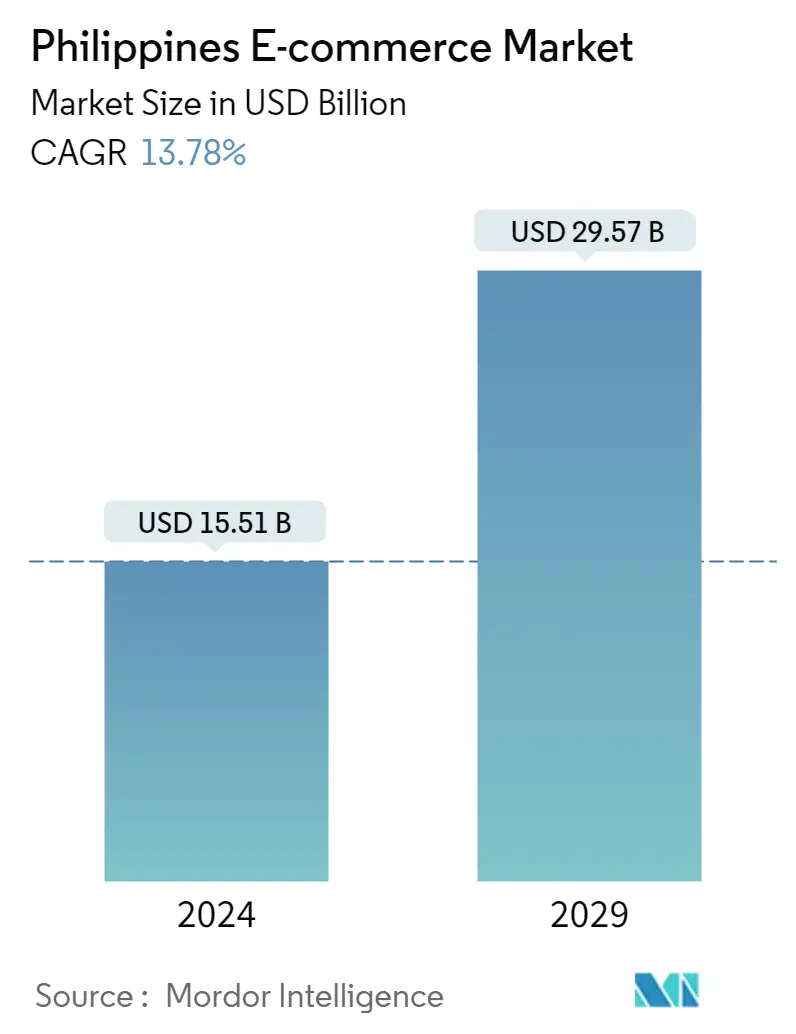
| Study Period | 2019 - 2029 |
| Base Year For Estimation | 2023 |
| Market Size (2024) | USD 15.51 Billion |
| Market Size (2029) | USD 29.57 Billion |
| CAGR (2024 - 2029) | 13.78 % |
| Market Concentration | Medium |
Major Players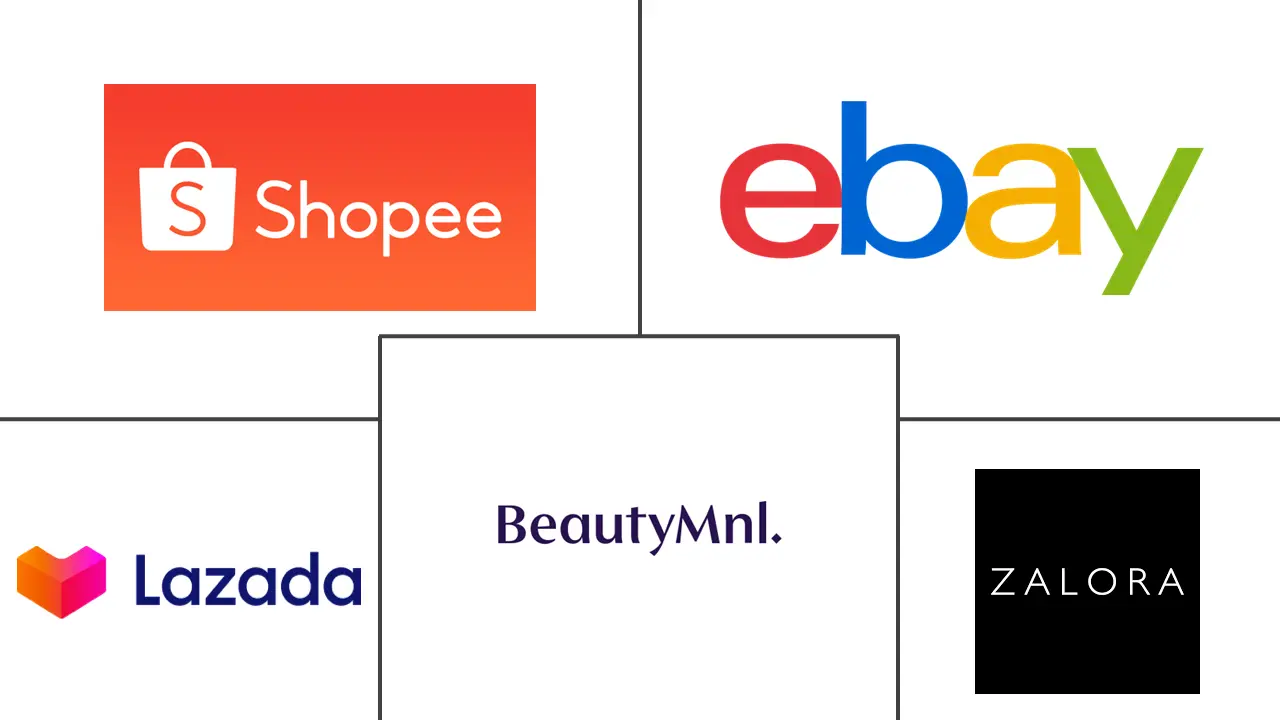
*Disclaimer: Major Players sorted in no particular order |
Philippines E-commerce Market Analysis
The Philippines E-commerce Market size is estimated at USD 15.51 billion in 2024, and is expected to reach USD 29.57 billion by 2029, growing at a CAGR of 13.78% during the forecast period (2024-2029).
The market has grown in recent years, boosted by evolving consumer preferences for online shopping and increasing internet penetration in the region. The COVID-19 pandemic further accelerated this trend, attracting more sellers to utilize the reach and other benefits offered by the E-commerce platforms in the Philippines.
- With a vibrant economy and a large population savvy in digital technology, the Philippines is a fast-growing E-commerce market in Southeast Asia. Some websites and digital applications are competing for market share with global, regional, and domestic players. Increasing connectivity in the Philippines and rapidly overcoming Filipino infrastructure problems has made more and more of the large population access the Internet. Connected Filipinos access the country's E-commerce market primarily through mobile devices and computers.
- Every year, the need for speedy delivery services and E-commerce sales grows in the Philippines. Some of the most well-known businesses in the region and the surrounding area are opting for Quadx, which deploys new solutions to deliver products on time. For instance, in June 2022, using FarEye's Intelligent Delivery platform, QuadX has seen a significant increase in successful on-time, accurate deliveries and significant productivity gains in delivery. Since adopting FarEyein 2018, QuadXhas created an extremely competitive, unique delivery platform with FarEye that can fulfill 307% more orders.
- Among the 132 economies in the Global Innovation Index 2021, the Philippines is ranked 51st. Technologies like Augmented Reality (AR) are improving the shopping experience, focusing on customer experience. For instance, Shopify AR from Shopify allows the users to add AR functionality to their online store, allowing them to experience the product through AER. Some of the brands utilizing the technology include Spoikeball, allbirds, BioLite, etc.
- Despite the Philippines' rapid development rate, it has yet to make more efficient and usable technology and management available to a larger audience. The lack of action by government leaders and local organizations to improve the country's technology and online industries through defining infrastructural projects has also hampered advances in E-commerce. Regarding internet speeds, carriers and governments need improvements in the country to handle the increasing traffic in the region.
- Due to the COVID-19 pandemic, the demand for E-commerce in the Philippines is increasing, as the country's economy still relies on E-commerce for recovery from the outbreak. According to data from the Philippine Department of Trade and Industry (DTI), E-commerce increased the nation's GDP by 3.4%, or USD 12 billion, in 2020. In addition, the DTI wants to see a growth in E-commerce businesses from 500,000 in 2020 to 750,000 by 2021 and 1 million by 2022. The fast-growing middle class, high consumer spending, and an emerging technical population all contribute to the growth of E-commerce.
Philippines E-commerce Market Trends
This section covers the major market trends shaping the Philippines E-commerce Market according to our research experts:
Fashion Industry to Dominate the Market Significantly
- Filipinos were skeptical about spending money on the internet, which changed during the COVID-19 pandemic. The blockage forced Filipinos to buy groceries and other necessities online, causing an explosive increase in E-commerce transactions. Filipino entrepreneurs quickly caught up, with thousands of entrepreneurs setting up E-commerce stores selling everything from face masks to Adobe. This also included large companies doubling their E-commerce efforts in the fashion and beauty industry.
- The E-commerce landscape of the Philippines is constantly growing and evolving with its neighbors in Southeast Asia. In fashion retail, physical stores in malls have been a major business model for decades, but pandemics have changed it all. The people in the country are choosing a specific business model that is scalable, fits their product, and fits the target audience.
- The Philippines has encouraged new companies in the fashion industry to enter their country for the past few years. This has led to the market's continued growth and has been observed in the wholesale and retail sectors, leveraging the e-commerce market with new brands in the country.
- Several international brands expand in the Philippines to explore the increasing demands for fashion commodities, leveraging the reach through existing E-commerce platforms. In January 2022, Zalora partnered with minimalist fashion brand COS to enter the Philippines fashion market after targeting Singapore and Malaysia through the Zalora E-commerce platform, with Zalora featuring exclusive availability of COS products.
- The fashion E-commerce in the Philippines witnesses considerable investments for upscaling the platforms. According to Forbes, in May 2022, the Lazada E-commerce platform received an investment of USD 378.5 million from the parent investor, Alibaba.com, since its initial investment of around USD 1.3 billion in June 2020. Fashion E-commerce sites have been hit in the region as clothing and apparel have made life easier for online shoppers staying home.
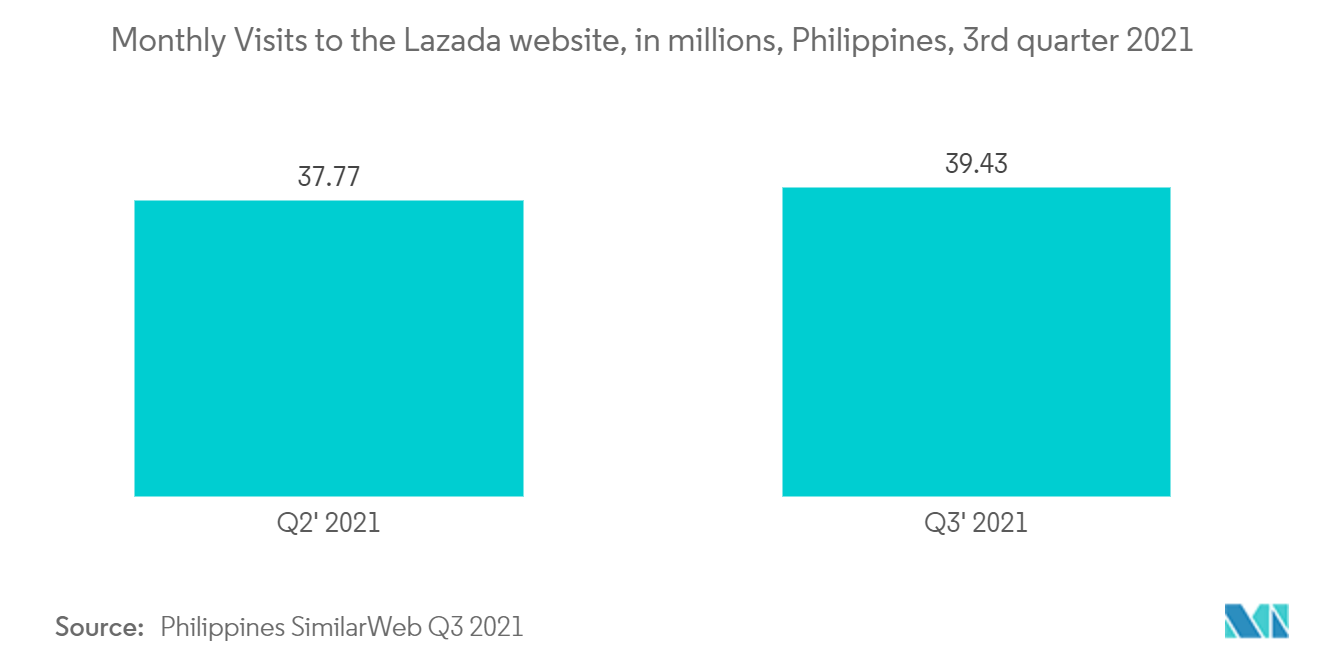
Increased Internet Use, Online Payments, and Mobile Phones Bolstered the Market Growth
- The E-commerce industry in the Philippines has a high potential for growth and development. This is mainly driven by Filipino consumers adapting to a digital lifestyle. According to the World Bank, the Philippines is one of the most dynamic economies in the East Asia Pacific region. The E-commerce platforms and the evolving fintech sector leverage the same.
- Coupled with the accelerated growth of GDP, the Philippines is a significant destination for digital transformation. Other industries also benefit from the development of E-commerce. These industries include telecommunications (data boom), logistics and warehousing (supply chain), and social media. Shopping malls, retail chains, and lifestyle brands can also benefit from increased domestic internet usage by trying to innovate their businesses through the e-commerce industry.
- The increasing use of mobile phones in the region has given a major push to E-commerce platforms, as mobile phones and Apps provider one of the easiest access to these platforms. According to data from GSMA Intelligence, at the beginning of 2022, the Philippines had around 156.5 million active mobile connections, indicating considerable potential in utilizing the reach offered by the mobile apps of the E-commerce platforms.
- One of the major issues the E-commerce platforms from flourishing in the Philippines is slow internet speed. According to the global ranking by Speedtest Global Index for July 2022, the Philippines ranked 84 with a median mobile internet download speed of 22.56 Mbps and 46 with a median fixed broadband internet downloading speed of 75.62 Mbps.
- Many companies are planning to enter the market to improve the internet. According to Bloomberg, in May 2022, the Philippines national Telecommunications Commission approved Starlink's registration as a value-added service provider. The company plans to deploy direct access through satellite systems and build and operate broadband facilities in the Philippines.
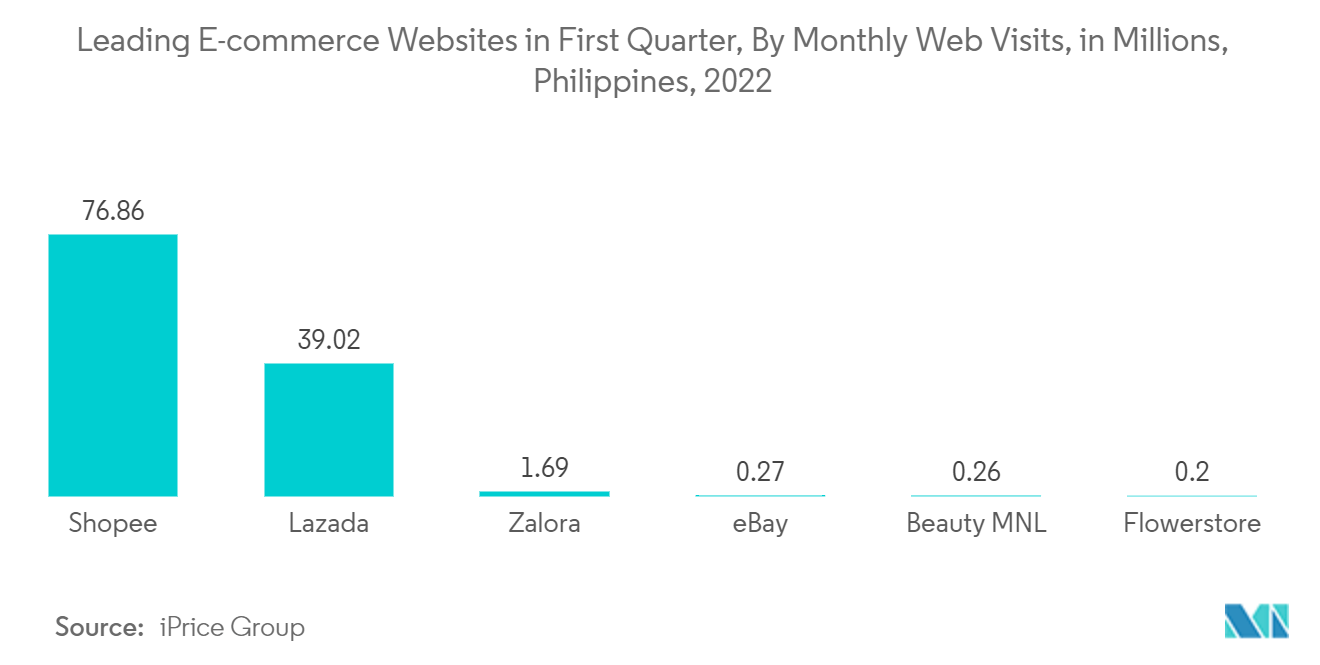
Philippines E-commerce Industry Overview
The Philippines' E-commerce is moderately fragmented with the presence of key players in the country. The market might get highly competitive with the entry of new players, and international players entering the country leverages the E-commerce market. The platforms welcome new sellers through different programs with partnerships. Companies also focus on expanding their reach by providing better service to sellers and faster delivery to shoppers across other regions in the Philippines.
- August 2022 - Shopee launched their third ASEAN Online Sale Day, partnering with the Bureau of International Trade Relations (BITR) and the Department of Trade and Industry (DTI) from August 8 to 10. The annual sale celebrated the 55th founding anniversary of the Association of Southeast Asian Nations (ASEAN) and showcased different regional and local products on the Shopee platform. Over the last three years, the ASEAN Online Sale has consistently offered users a vast range of quality products across the region.
- April 2022 - Lazada has announced the official launch of Lazada One, the Group's regional headquarters and office in Singapore. Lazada has a strong presence in Southeast Asia and aims to expand the digitization of the region further. The company aims to empower women and young people across Southeast Asia, educate them in the digital economy, and provide scholarships and growth opportunities to break the digital divide. This will enable continuous exposure to six markets in Southeast Asia, including Indonesia, Malaysia, Philippines, Singapore, Thailand, and Vietnam.
Philippines E-commerce Market Leaders
-
Lazada Group
-
eBay
-
Zalora
-
Shopee
-
BeautyMNL (Taste Central Curators Inc.)
*Disclaimer: Major Players sorted in no particular order
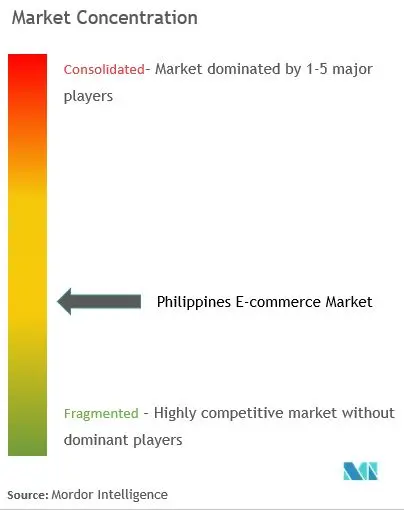
Philippines E-commerce Market News
- July 2022 - eBay and FedEx partner to strengthen delivery services in the Asia Pacific, offering service options at competitive prices. The partnership would allow eBay sellers to avail of premium delivery options through FedEx, including cross-border services like FedEx Ecletrocinc Trade Documents and FedEx Home Delivery for delivery and returns.
- June 2022 - Shopee expanded Shopee Xpress hubs across Mindanao, along with seller-onboarding initiatives. These new hubs were established in Davao Del Sur, Davao City, Davao Del Norte, and other areas, which implied a shorter time for Davao to Davao deliveries. The seller initiatives encouraged sellers to use the E-commerce platform for nationwide reach and business.
- May 2022 - Lazada Philippines partnered with GrabExpress to launch Same Day Delivery, starting from Metro Manila. The Same Day Delivery aims to reduce the standard waiting time of 3-5 days to receive the purchases to just a few hours, including commodities like groceries, party supplies, etc.
Philippines E-commerce Market Report - Table of Contents
1. INTRODUCTION
- 1.1 Study Assumptions and Market Definitions
- 1.2 Scope of the Study
2. RESEARCH METHODOLOGY
3. EXECUTIVE SUMMARY
4. MARKET INSIGHTS
- 4.1 Market Overview
-
4.2 Industry Attractiveness-Porter's Five Forces Analysis
- 4.2.1 Bargaining Power of Suppliers
- 4.2.2 Bargaining Power of Buyers/Consumers
- 4.2.3 Threat of New Entrants
- 4.2.4 Threat of Substitute Products
- 4.2.5 Intensity of Competitive Rivalry
- 4.3 Key Market Trends and Share of E-commerce of Total Retail Sector
- 4.4 Impact of COVID-19 on the E-commerce Sales
5. MARKET DYNAMICS
-
5.1 Market Drivers
- 5.1.1 Growing Demand from Fashion Industry
- 5.1.2 Penetration of Internet and Smartphone Usage
-
5.2 Market Challenges
- 5.2.1 Low Internet Speed
- 5.3 Analysis of Key Demographic Trends and Patterns Related to E-commerce Industry in Philippines (Coverage to include Population, Internet Penetration, E-commerce Penetration, Age & Income etc.)
- 5.4 Analysis of the Key Modes of Transaction in the E-commerce Industry in Philippines (Coverage to Include Prevalent Modes of Payment such as Cash, Card, Bank Transfer, Wallets, etc.)
- 5.5 Analysis of Cross-Border E-commerce Industry in Philippines (Current Market Value of Cross-Border & Key trends)
- 5.6 Current Positioning of Country Philippines in the E-commerce Industry in Asia-Pacific
6. MARKET SEGMENTATION
-
6.1 By B2C E-commerce
- 6.1.1 Market Size (GMV) for the Period of 2017-2027
- 6.1.2 Market Segmentation - by Application
- 6.1.2.1 Beauty & Personal Care
- 6.1.2.2 Consumer Electronics
- 6.1.2.3 Fashion & Apparel
- 6.1.2.4 Food & Beverage
- 6.1.2.5 Furniture & Home
- 6.1.2.6 Others (Toys, DIY, Media, etc.)
-
6.2 By B2B E-commerce
- 6.2.1 Market Size for the Period of 2017-2027
7. COMPETITIVE LANDSCAPE
-
7.1 Company Profiles
- 7.1.1 Lazada Group
- 7.1.2 Shopee
- 7.1.3 eBay Inc.
- 7.1.4 Zalora
- 7.1.5 Metrodeal
- 7.1.6 Carousell
- 7.1.7 Galleon (Sterling Galleon Corporation)
- 7.1.8 BeautyMNL (Taste Central Curators Inc.)
- 7.1.9 Inter IKEA Systems B.V.
- 7.1.10 Ubuy Co.
- 7.1.11 Sephora Digital SEA Pte Ltd
- 7.1.12 Kimstore
- 7.1.13 Perfume Philippines
- *List Not Exhaustive
8. INVESTMENT ANALYSIS
9. FUTURE OUTLOOK OF MARKET
** Subject To AvailablityPhilippines E-commerce Industry Segmentation
E-commerce is the buying and selling of goods and services over the internet through online shopping. However, this term is often used to describe all the seller's efforts in selling products directly to consumers. It begins when potential customers learn about a product, buy it, use it, and ideally maintain lasting customer loyalty.
The scope of the study is limited to tracking the revenue generated through the e-commerce market in the Philippines. The study also tracks key market metrics, underlying growth influencers, and significant industry vendors, providing support for market estimates and growth rates in the Philippines e-commerce market throughout the anticipated period. The study looks at Covid-19's overall influence on the ecosystem. The report's scope includes market size and forecasting for B2B and B2C segments, with the qualitative analysis of the B2C channel being further split by application.
| By B2C E-commerce | Market Size (GMV) for the Period of 2017-2027 | |
| Market Segmentation - by Application | Beauty & Personal Care | |
| Consumer Electronics | ||
| Fashion & Apparel | ||
| Food & Beverage | ||
| Furniture & Home | ||
| Others (Toys, DIY, Media, etc.) | ||
| By B2B E-commerce | Market Size for the Period of 2017-2027 |
Philippines E-commerce Market Research FAQs
How big is the Philippines E-commerce Market?
The Philippines E-commerce Market size is expected to reach USD 15.51 billion in 2024 and grow at a CAGR of 13.78% to reach USD 29.57 billion by 2029.
What is the current Philippines E-commerce Market size?
In 2024, the Philippines E-commerce Market size is expected to reach USD 15.51 billion.
Who are the key players in Philippines E-commerce Market?
Lazada Group, eBay, Zalora, Shopee and BeautyMNL (Taste Central Curators Inc.) are the major companies operating in the Philippines E-commerce Market.
What years does this Philippines E-commerce Market cover, and what was the market size in 2023?
In 2023, the Philippines E-commerce Market size was estimated at USD 13.63 billion. The report covers the Philippines E-commerce Market historical market size for years: 2019, 2020, 2021, 2022 and 2023. The report also forecasts the Philippines E-commerce Market size for years: 2024, 2025, 2026, 2027, 2028 and 2029.
Philippines E-commerce Industry Report
The E-commerce industry in the Philippines is experiencing significant growth, driven by various market segments including B2C E-commerce such as beauty and personal care, consumer electronics, fashion and apparel, food and beverage, and furniture and home, as well as B2B E-commerce. The industry analysis provides a comprehensive market overview and industry outlook, highlighting key industry trends and growth rates.
Industry reports indicate substantial market growth, with industry statistics reflecting an upward trajectory in industry sales and market value. The market forecast suggests continued expansion, supported by detailed market segmentation and market data. Research companies have provided a thorough market review, emphasizing the importance of industry research in understanding market predictions and identifying market leaders.
The industry information gathered points to a robust market outlook, with industry size and industry trends playing a pivotal role in shaping the future of the E-commerce sector in the Philippines. The report pdf offers an in-depth report example, showcasing the market overview and market segmentation, essential for stakeholders to make informed decisions.
Overall, the industry reports and industry analysis underscore the dynamic nature of the E-commerce market, with a strong emphasis on market value and market growth. The insights provided by market leaders and research companies are crucial for navigating the evolving landscape of the E-commerce industry.



